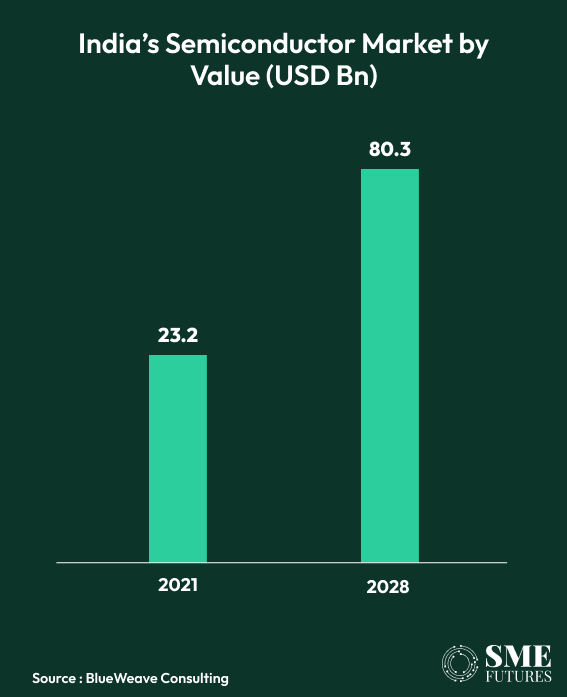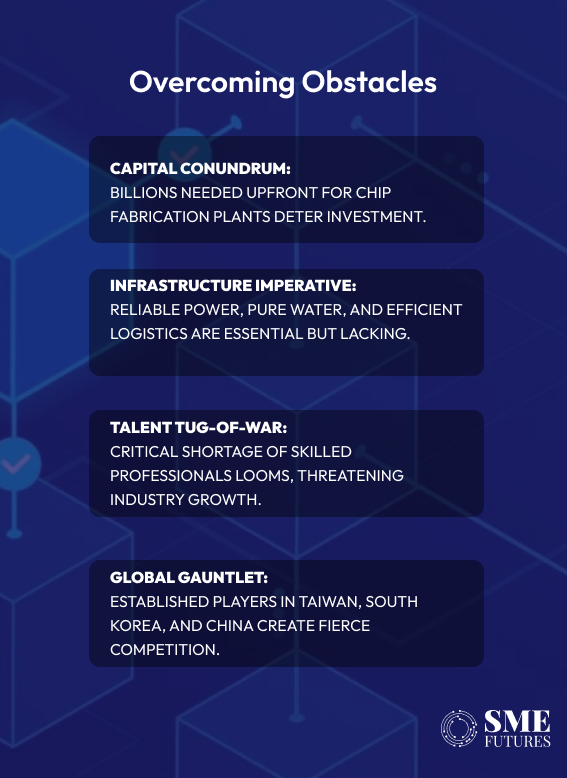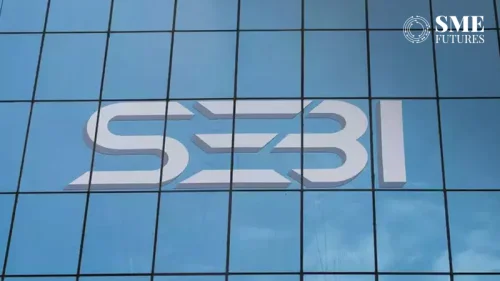In this digital age, where smartphones are extensions of ourselves, electric vehicles promise a greener future, and artificial intelligence reshapes industries, there is an unsung hero: the semiconductor. These tiny chips, often no bigger than a fingernail, are the beating heart of modern technology. As the world clamours for faster, smarter, and more connected devices, the demand for semiconductors has skyrocketed.
India, a nation renowned for its software prowess, is now poised to take centre stage in this global symphony of semiconductor innovation. A combination of factors, including government initiatives, surging domestic demand, and a burgeoning talent pool, are propelling India towards semiconductor self-sufficiency and global prominence.

The semiconductor sonata: More than meets the eye

Semiconductors, often called the “new oil” of the digital era, are far more than mere electronic components. They are the backbone of critical infrastructure, defence systems, and cutting-edge technologies. From powering the latest smartphones to enabling life-saving medical devices and buoying advancements in artificial intelligence, semiconductors touch every aspect of our lives.
“Semiconductors are not just in your phone or computer; they’re in everything from medical equipment to satellites. In the next decade, we hope to provide chips for various devices across industries—both IoT and other use cases. With other nascent Indian companies, we hope to co-create a robust Indian chip-design ecosystem,” asserts Shashwath TR, Co-founder & CEO of Mindgrove Technologies.
India’s semiconductor journey began with a focus on design. Global tech giants recognised the nation’s rich talent pool and established design centres here, tapping into the expertise of Indian engineers.
“India has a strong foundation in semiconductor design, established since the 1980s with global giants like Texas Instruments and Analog Devices. Today, all top 25 semiconductor companies have substantial design teams in India,” says Somshubhro (Som) Pal Choudhury, Co-Founder & Partner at Bharat Innovation Fund.
Now, the spotlight is shifting towards manufacturing. The Indian Government has launched ambitious initiatives like the Production Linked Incentive (PLI) and Design Linked Incentive (DLI) schemes to attract investments and foster a robust semiconductor ecosystem.
“The PLI scheme has been instrumental in fortifying India’s semiconductor manufacturing capabilities… The scheme’s incentives have enabled us to expand our manufacturing capacity and invest in state-of-the-art technologies, positioning us as a preferred partner for high-performance computing (HPC) and AI solutions,” says Hirdey Vikram, CMO of Netweb Technologies.
On the impact of the DLI scheme, he adds, “This scheme has facilitated increased investment in our R&D capabilities, enabling us to accelerate the development of advanced designs tailored to specific market needs.”
India’s semiconductor symphony: Key movements

Several key trends are shaping India’s semiconductor symphony:
Rise of fabless companies: Fabless companies like Mindgrove Technologies are flourishing, focusing on innovative chip design while outsourcing manufacturing. This model leverages India’s design strengths and fosters a vibrant start-up ecosystem.
Emerging technologies at the forefront: Indian companies are harnessing their software expertise to design chips for cutting-edge technologies like AI, 5G, and IoT. “AI is driving demand for specialised chips, but India’s primary opportunity lies in software and toolchain development for AI chips. In the 5G domain, India’s opportunity is more systems-oriented, leveraging its expertise in telecommunications software and network design for a large domestic strategic market,” Som Pal Choudhury highlights.
Domestic market expansion: India’s burgeoning consumer market and the government’s “Make in India” initiative are driving local demand for electronics, creating a fertile ground for semiconductor growth.
“Needless to say, there is a huge potential to grow in this market and even the government sees the same and that’s why they are launching various schemes to develop and evolve the Indian semiconductor industry,” says Shishir Gupta, CEO of Riot Labz and Oakter.
Strategic imperative: Semiconductors are essential for national security and defence. India’s push for self-reliance in this sector is a strategic move to reduce dependence on imports and strengthen its technological capabilities.
“Given the increasing geopolitical uncertainties and supply chain disruptions, establishing a self-reliant semiconductor ecosystem is not just an economic imperative but a matter of national security,” Vikram points out.
Navigating the complex rhythms: Challenges ahead

While the symphony of India’s semiconductor rise is harmonious, it’s not without its challenging chords. The path to becoming a global semiconductor powerhouse is fraught with complexities that demand careful navigation.
Capital crescendo: Building a semiconductor fabrication plant (fab) is a monumental undertaking, requiring billions of dollars in investment. Attracting and sustaining such massive investments is a significant hurdle for India. As Somshubhro Pal Choudhury aptly puts it, “The primary challenges include high capital investment for chip fabs and the ongoing financial pressures to keep up with technological advancements.”
Infrastructure cadence: Semiconductor manufacturing is a delicate dance that requires a well-orchestrated infrastructure. Reliable power grids, access to ultra-pure water, and efficient logistics networks are non-negotiable. Gupta says, “We need more support from the government in terms of infrastructure development… so that we can utilise that infrastructure to the fullest.”
Talent concerto: A skilled workforce is the backbone of any thriving industry. However, a report by TeamLease Degree Apprenticeship predicts a shortage of 250,000 to 300,000 semiconductor professionals by 2027, spanning critical areas like design, manufacturing, and packaging. This looming deficit underscores the urgency for comprehensive skill development initiatives.
Global competition rhapsody: India’s semiconductor aspirations face stiff competition from established players like Taiwan, South Korea, and China, who have a head start in terms of experience, infrastructure, and supply chains.
“Although companies are now aware, it’s also true that China has made itself difficult to replace,” says Gupta. To thrive in this competitive landscape, India must carve out its niche, focusing on areas where it can offer unique value and innovation.
Regulatory harmonisation: A conducive regulatory environment is crucial for attracting investments and fostering innovation. While the government’s PLI and DLI schemes are positive steps, further streamlining of regulations and approval processes is essential to create a frictionless experience for semiconductor companies.

Overcoming these challenges requires a symphony of solutions: sustained government support, robust industry-academia collaborations, targeted skill development programmes, and strategic international partnerships. As India navigates these complex rhythms, it must strike a balance between ambition and pragmatism, ensuring that its semiconductor industry not only flourishes but also contributes to a sustainable and technologically advanced future.
A crescendo of collaboration and innovation
Collaboration is the key to unlocking India’s full potential in the semiconductor sector.
Som Pal Choudhury suggests a “mission mode” approach, fostering partnerships between start-ups, academia, and industry giants.
“Establish a semiconductor design and innovation centre, modelled after IMEC in Belgium, focusing on AI chip design, 5G systems, and RISC-V-based IoT solutions. Create a dedicated semiconductor start-up fund, with matching grants from industry leaders, specifically for projects involving academia-industry collaboration,” he contends.
He also suggests a “chip design challenge” programme and a “semiconductor talent exchange programme” to foster innovation and knowledge exchange.
As India’s semiconductor industry grows, it’s imperative to prioritise sustainability.
“India needs to advance its semiconductor manufacturing industry with the lowest environmental footprint. This includes adopting energy-efficient processes, water recycling systems, and green chemistry practices,” Choudhury avers.
“Sustainability is not just a buzzword; it’s a core value that will shape the future of the semiconductor industry. We are committed to integrating eco-friendly practices into our operations and developing energy-efficient solutions,” Vikram adds.
India’s semiconductor symphony is a composition of innovation, investment, and indigenous growth. With the right notes in place, India’s semiconductor industry is set to create a harmonious melody that resonates globally. The challenges are real, but the opportunities are immense. As India fine-tunes its semiconductor strategy and invests in talent and infrastructure, it’s poised to emerge as a key player in the global tech arena, contributing to a brighter and more technologically advanced future for all.










